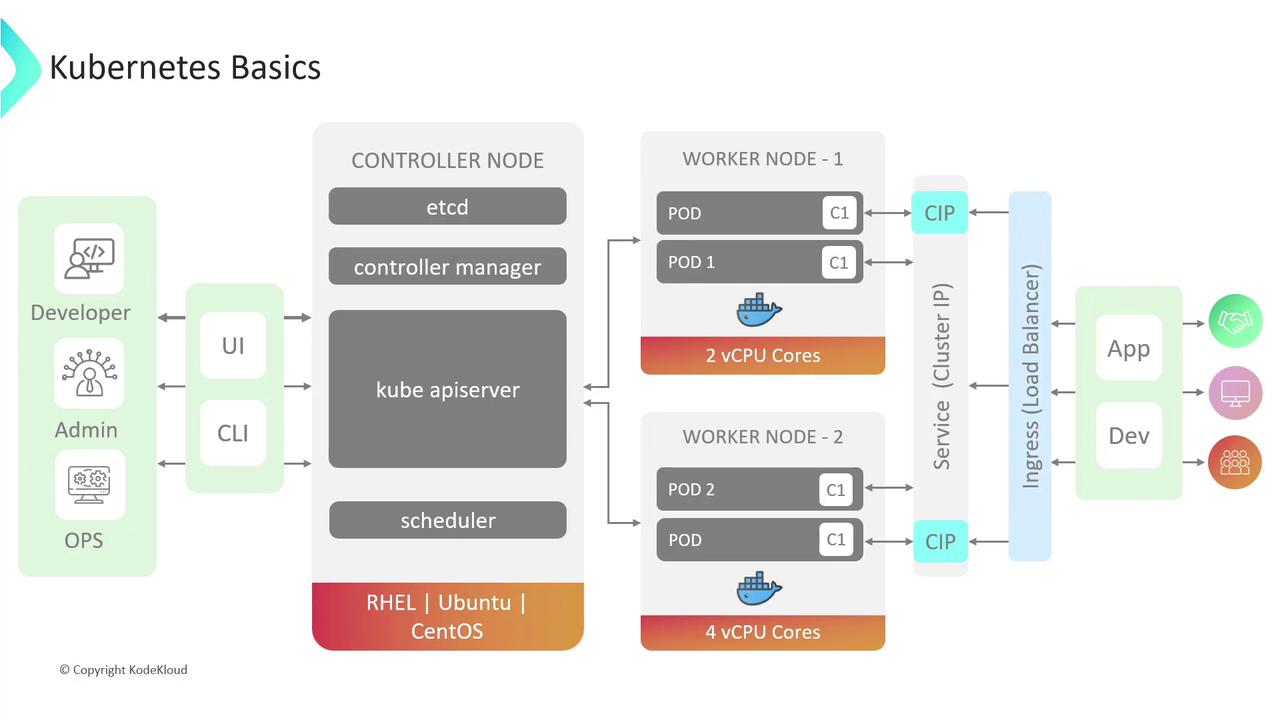GitHub Actions Certification
Continuous Deployment with GitHub Actions
Brief Overview on Kubernetes
Kubernetes is an open-source container orchestration platform, originally developed by Google and now maintained by the Cloud Native Computing Foundation (CNCF). It automates deployment, scaling, and management of containerized applications, making it a cornerstone technology for modern cloud-native architectures.
Kubernetes Architecture
A Kubernetes cluster is composed of two main node types:
Control Plane Nodes
Hosts the core components that manage cluster state and orchestration:- etcd: Distributed key-value store for all cluster data.
- kube-apiserver: Central API endpoint for administrative operations.
- kube-controller-manager: Runs controllers to reconcile desired vs. actual state.
- kube-scheduler: Assigns Pods to Nodes based on resource requirements.
Worker Nodes
Runs application workloads and contains:- kubelet: Ensures containers in Pods are healthy and running.
- kube-proxy: Configures network routes and load balancing for Services.
- Container runtime (e.g., Docker, containerd).

Pods
A Pod is the smallest deployable unit in Kubernetes, encapsulating one or more containers that share networking and storage. Containers within a Pod communicate over localhost and share volume mounts.
Example Pod manifest:
apiVersion: v1
kind: Pod
metadata:
name: my-pod
spec:
containers:
- name: web
image: nginx:latest
ports:
- containerPort: 80
Note
By default, Pods use restartPolicy: Always. While containers will restart on failure, if the Pod object is deleted or its Node fails, Kubernetes will not recreate it unless managed by a higher-level controller (see Deployments).
Controllers: ReplicaSets & Deployments
Controllers ensure your Pods maintain the desired state and scale automatically.
| Controller | Purpose | Definition Example |
|---|---|---|
| ReplicaSet | Maintains a specified number of identical Pods. | kind: ReplicaSet |
| Deployment | Declarative updates, rollbacks, and scaling of Pods. | kind: Deployment |
Example Deployment manifest:
apiVersion: apps/v1
kind: Deployment
metadata:
name: nginx-deployment
spec:
replicas: 3
selector:
matchLabels:
app: nginx
template:
metadata:
labels:
app: nginx
spec:
containers:
- name: nginx
image: nginx:1.21
ports:
- containerPort: 80
With a Deployment, you declare the desired state—such as replica count and container image—and Kubernetes handles rolling updates, rollbacks, and Pod rescheduling.
Services
Services provide stable network endpoints for Pods, decoupling clients from dynamically assigned Pod IPs. Kubernetes supports several Service types:
| Type | Description | Use Case |
|---|---|---|
| ClusterIP | Internal-only cluster IP (default). | In-cluster communication. |
| NodePort | Exposes Service on each Node’s IP at a static port. | Simple external access on known port. |
| LoadBalancer | Provisions cloud provider LB to route traffic externally. | Production-grade external access. |
Example LoadBalancer Service:
apiVersion: v1
kind: Service
metadata:
name: web-service
spec:
type: LoadBalancer
selector:
app: nginx
ports:
- port: 80
targetPort: 80
Warning
LoadBalancer Services may incur additional cloud provider costs. To consolidate routing for multiple hostnames or paths under a single IP, consider using an Ingress resource.
Ingress
Ingress manages HTTP/HTTPS routing into the cluster with host- and path-based rules. Unlike a LoadBalancer, Ingress can serve multiple domains or paths on one IP.
Example Ingress manifest:
apiVersion: networking.k8s.io/v1
kind: Ingress
metadata:
name: example-ingress
spec:
rules:
- host: example.com
http:
paths:
- path: /
pathType: Prefix
backend:
service:
name: web-service
port:
number: 80
References
- Kubernetes Documentation
- Cloud Native Computing Foundation (CNCF)
- Docker Official Site
- containerd Project
Watch Video
Watch video content